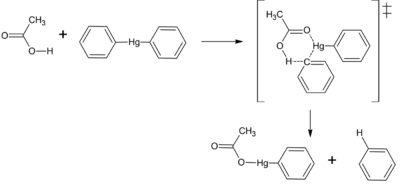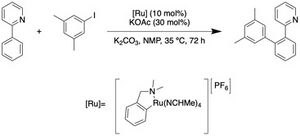Chemistry:Concerted metalation deprotonation
Concerted metalation-deprotonation (CMD) is a mechanistic pathway through which transition-metal catalyzed C–H activation reactions can take place. In a CMD pathway, the C–H bond of the substrate is cleaved and the new C–Metal bond forms through a single transition state.[1] This process does not go through a metal species that is bound to the cleaved hydrogen atom. Instead, a carboxylate or carbonate base deprotonates the substrate.[2] The first proposal of a concerted metalation deprotonation pathway was by S. Winstein and T. G. Traylor in 1955 for the acetolysis of diphenylmercury.[3] It was found to be the lowest energy transition state in a number of computational studies,[4] was experimentally confirmed through NMR experiments,[5][6] and has been hypothesized to occur in mechanistic studies.[7] While there are a number of different possible mechanisms for C–H activation, a CMD pathway is common for high valent, late transition metals like PdII,[8] RhIII, IrIII, and RuII.[9] The C–H bonds that have been found to undergo C–H activation through CMD include those that are aryl,[1] alkyl,[10][11] and alkenyl.[2] Investigations into CMD paved the way for the development of many new C–H functionalization reactions, especially in the areas of direct arylation and alkylation by palladium and ruthenium.[2]
Mechanism
CMD begins with a high valent, late transition metal like PdII that may or may not be bound to a carboxylate anion.[1] The computed transition state involves concerted partial formation of a carbon–metal bond and partial protonation of the carboxylate. At the same time, any anionic metal–carboxylate bond begins to break, as does the carbon–hydrogen bond that is being activated. Compared to other possible processes such as oxidative addition of the C–H bond to the metal, CMD is lower in energy in many cases.[12] A transition state in which the carboxylate is bound to the metal can be referred to as either CMD or AMLA, which stands for "ambiphilic metal–ligand assistance," but the latter emphasizes that the carboxylate acts as a ligand during the transition state.[4]
History
In 1955, S. Winstein and T. G. Traylor published a study of the mechanism of acetolysis of organomercury compounds. They propose a series of possible mechanisms for the process, which they rule out through based on their kinetic data. A concerted metalation deprotonation is considered, and they are unable to rule it out through the data they collect.
The metalation of organic C–H bonds was extended from mercury to palladium in 1968 by J. M. Davidson and C. Triggs who identified that palladium acetate reacts with benzene in perchloric acid and acetic acid to give biphenyl, palladium(0), and 2 equivalents of acetic acid through an organopalladium intermediate.[13] Early mechanistic studies found that palladium acetate was the best palladium precatalyst due to the presence of the acetate ligand.[1] Mechanistic investigation has been ongoing since these initial discoveries, and infrared spectroscopy on the picosecond–millisecond time scale was used in 2021 to observe the states involved in proton transfer from acetic acid to a metalated ligand, which is the microscopic reverse of a concerted metalation deprotonation process.[14]
Examples
Reaction systems that are less efficient or entirely inactive in the absence of carboxylate acids and bases are likely to occur through a concerted metalation protonation reaction pathway.[14] An example of such a reaction with an sp3 C–H bond that was reported in 2007 by Keith Fagnou and coworkers is an intramolecular cyclization that uses a palladium catalyst.[15]
A notable example of a reaction that is catalyzed by ruthenium in which directed metalation occurs through CMD was reported by Igor Larossa and coworkers in 2018. The ruthenium catalyst is functional group tolerant and enables the late stage synthesis of pharmaceutically relevant biaryls.[16]
Importance of carboxylate
Many C–H activation reactions, particularly those involving late transition metals, require carboxylate or carbonate bases.[11] The need for this reaction component often suggests the occurrence of a CMD pathway.[2] However, in order to be classified as CMD, the transition state does not need to involve the carboxylate as a ligand on the metal.[4] Common sources of carboxylate include pivalate, acetate, and benzoate.[1]
References
- ↑ 1.0 1.1 1.2 1.3 1.4 Lapointe, David; Fagnou, Keith (2010-09-18). "Overview of the Mechanistic Work on the Concerted Metallation–Deprotonation Pathway". Chemistry Letters 39 (11): 1118–1126. doi:10.1246/cl.2010.1118. ISSN 0366-7022. https://www.journal.csj.jp/doi/10.1246/cl.2010.1118.
- ↑ 2.0 2.1 2.2 2.3 Ackermann, Lutz (2011-03-09). "Carboxylate-Assisted Transition-Metal-Catalyzed C−H Bond Functionalizations: Mechanism and Scope". Chemical Reviews 111 (3): 1315–1345. doi:10.1021/cr100412j. ISSN 0009-2665. PMID 21391562. https://doi.org/10.1021/cr100412j.
- ↑ Winstein, S.; Traylor, T. G. (1955-07-01). "Mechanisms of Reaction of Organomercurials. II. Electrophilic Substitution on Saturated Carbon. Acetolysis of Dialkylmercury Compounds". Journal of the American Chemical Society 77 (14): 3747–3752. doi:10.1021/ja01619a021. ISSN 0002-7863. https://doi.org/10.1021/ja01619a021.
- ↑ 4.0 4.1 4.2 Davies, David L.; Macgregor, Stuart A.; McMullin, Claire L. (2017-07-12). "Computational Studies of Carboxylate-Assisted C–H Activation and Functionalization at Group 8–10 Transition Metal Centers". Chemical Reviews 117 (13): 8649–8709. doi:10.1021/acs.chemrev.6b00839. ISSN 0009-2665. PMID 28530807. https://doi.org/10.1021/acs.chemrev.6b00839.
- ↑ Kapdi, Anant R. (2014-01-29). "Organometallic aspects of transition-metal catalysed regioselective C–H bond functionalisation of arenes and heteroarenes" (in en). Dalton Transactions 43 (8): 3021–3034. doi:10.1039/C3DT52737A. ISSN 1477-9234. PMID 24419051. https://pubs.rsc.org/en/content/articlelanding/2014/dt/c3dt52737a.
- ↑ Olah, George A.; Yu, Simon H.; Parker, David G. (1976-05-01). "Organometallic chemistry. XII. Proton and carbon-13 nuclear magnetic resonance study of arenemercurinium ions, the intermediate complexes of aromatic mercuration". The Journal of Organic Chemistry 41 (11): 1983–1986. doi:10.1021/jo00873a020. ISSN 0022-3263. https://doi.org/10.1021/jo00873a020.
- ↑ Fung, Chung W.; Khorramdel-Vahed, Mehdi; Ranson, Richard J.; Roberts, Roger M. G. (1980-01-01). "Kinetics and mechanism of mercuriation of aromatic compounds by mercury trifluoroacetate in trifluoroacetic acid" (in en). Journal of the Chemical Society, Perkin Transactions 2 (2): 267–272. doi:10.1039/P29800000267. ISSN 1364-5471. https://pubs.rsc.org/en/content/articlelanding/1980/p2/p29800000267.
- ↑ Gorelsky, Serge I.; Lapointe, David; Fagnou, Keith (2008-07-29). "Analysis of the Concerted Metalation-Deprotonation Mechanism in Palladium-Catalyzed Direct Arylation Across a Broad Range of Aromatic Substrates". Journal of the American Chemical Society 130 (33): 10848–10849. doi:10.1021/ja802533u. ISSN 0002-7863. PMID 18661978. https://pubs.acs.org/doi/full/10.1021/ja802533u.
- ↑ Gensch, T.; Hopkinson, M. N.; Glorius, F.; Wencel-Delord, J. (2016-05-17). "Mild metal-catalyzed C–H activation: examples and concepts" (in en). Chemical Society Reviews 45 (10): 2900–2936. doi:10.1039/C6CS00075D. ISSN 1460-4744. PMID 27072661.
- ↑ He, Jian; Wasa, Masayuki; Chan, Kelvin S. L.; Shao, Qian; Yu, Jin-Quan (2016-12-02). "Palladium-Catalyzed Transformations of Alkyl C–H Bonds". Chemical Reviews 117 (13): 8754–8786. doi:10.1021/acs.chemrev.6b00622. ISSN 0009-2665. PMID 28697604.
- ↑ 11.0 11.1 Hartwig, John F. (2016-01-13). "Evolution of C–H Bond Functionalization from Methane to Methodology". Journal of the American Chemical Society 138 (1): 2–24. doi:10.1021/jacs.5b08707. ISSN 0002-7863. PMID 26566092. PMC 4809212. https://doi.org/10.1021/jacs.5b08707.
- ↑ García-Cuadrado, Domingo; de Mendoza, Paula; Braga, Ataualpa A. C.; Maseras, Feliu; Echavarren, Antonio M. (2007-05-01). "Proton-Abstraction Mechanism in the Palladium-Catalyzed Intramolecular Arylation: Substituent Effects". Journal of the American Chemical Society 129 (21): 6880–6886. doi:10.1021/ja071034a. ISSN 0002-7863. PMID 17461585. https://doi.org/10.1021/ja071034a.
- ↑ Davidson, J. M.; Triggs, C. (1968-01-01). "Reaction of metal ion complexes with hydrocarbons. Part I. 'Palladation' and some other new electrophilic substitution reactions. The preparation of palladium(I)" (in en). Journal of the Chemical Society A: Inorganic, Physical, Theoretical: 1324–1330. doi:10.1039/J19680001324. ISSN 0022-4944. https://pubs.rsc.org/en/content/articlelanding/1968/j1/j19680001324.
- ↑ 14.0 14.1 Hammarback, L. Anders; Aucott, Benjamin J.; Bray, Joshua T. W.; Clark, Ian P.; Towrie, Michael; Robinson, Alan; Fairlamb, Ian J. S.; Lynam, Jason M. (2021-01-27). "Direct Observation of the Microscopic Reverse of the Ubiquitous Concerted Metalation Deprotonation Step in C–H Bond Activation Catalysis". Journal of the American Chemical Society 143 (3): 1356–1364. doi:10.1021/jacs.0c10409. ISSN 0002-7863. PMID 33428402. https://doi.org/10.1021/jacs.0c10409.
- ↑ Lafrance, Marc; Gorelsky, Serge I.; Fagnou, Keith (2007-11-28). "High-Yielding Palladium-Catalyzed Intramolecular Alkane Arylation: Reaction Development and Mechanistic Studies". Journal of the American Chemical Society 129 (47): 14570–14571. doi:10.1021/ja076588s. ISSN 0002-7863. PMID 17985911. https://doi.org/10.1021/ja076588s.
- ↑ Simonetti, Marco; Cannas, Diego M.; Just-Baringo, Xavier; Vitorica-Yrezabal, Iñigo J.; Larrosa, Igor (July 2018). "Cyclometallated ruthenium catalyst enables late-stage directed arylation of pharmaceuticals" (in en). Nature Chemistry 10 (7): 724–731. doi:10.1038/s41557-018-0062-3. ISSN 1755-4349. PMID 29930274. Bibcode: 2018NatCh..10..724S. https://www.nature.com/articles/s41557-018-0062-3.
 |





